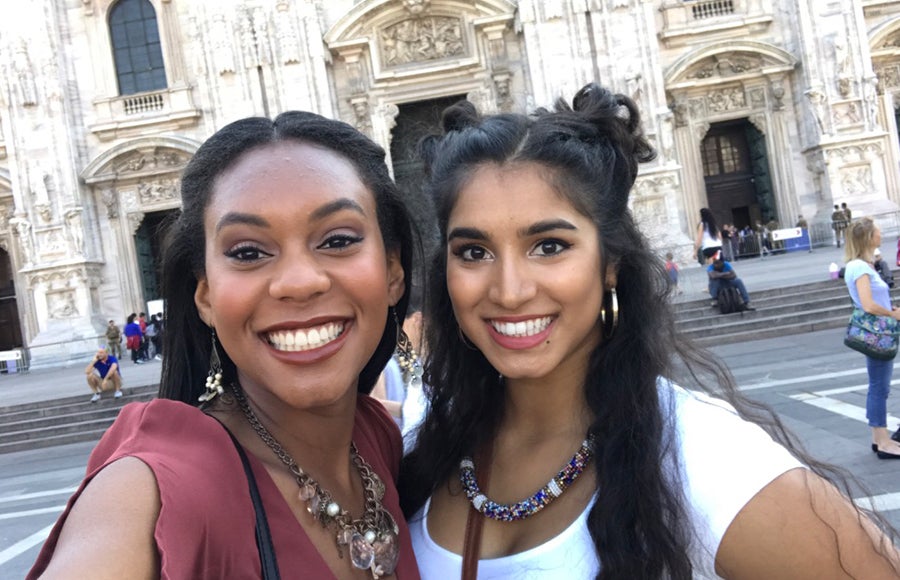
Two USC alumnae create a website offering a structured approach to fighting racism
“Would you do nothing if I was the one killed simply for my existence? Would you do anything differently than what you’re doing right now?”
When she heard her friend and former USC roommate Bryanna Wallace speak that line in an Instagram video Wallace had posted in the wake of George Floyd’s death at the hands of police, Autumn Gupta knew she had to do something, anything, to step up and be an active ally in the fight against systemic racism. So Gupta called Wallace and listened to her friend talk about her frustration, anger and sadness regarding a system that viewed people like her brother as an active threat, a country where white privilege was so woven into the nation’s social fabric that many people couldn’t see it at all.
“Bry and I had talked about things, but before then she hadn’t used her social media platform to say ‘This is what I go through every single moment of every single day.’ I realized that I have a lot more that I can do as an ally. That was my biggest light bulb moment, knowing I can’t just skate on by,” recalls Gupta, who graduated from USC Dornsife College of Letters, Arts and Sciences in 2020 with a B.A. in environmental studies and a B.S. in geodesign.
Determined to transform that conversation into action, the two women created “Justice in June,” a wildly popular Google Docs document that has since been expanded into a website that lists tangible steps people can take to become allies to the Black community. With a plethora of numerous links to different resources and even a schedule breaking down the reading, viewing or listening material into chunks of 10, 25 and 45 minutes that can be fit into a daily schedule, the site aims to be a resource for people looking for a way to structure their efforts to learn more about racism and become not just sympathetic, but anti-racist.
“We didn’t expect for this to take off in the way it did, but we want to continue building tools and resources. It’s what we call ‘capitalizing on that gap’ between good intentions and that lack of information and education that leads to action,” explains Wallace, who graduated in 2019 with a B.S. in business administration from the USC Marshall School of Business.
Two women of color at USC
Gupta, who is from a small town north of Kansas City, Missouri, and Wallace, who grew up in Orange County, California, met as freshman roommates at USC. They formed a close friendship that included open discussion of almost anything, including their faith and politics. As women of color — Gupta is half-Indian and half-white, and Wallace is half-Jamaican and half-African American — they often discussed racism, too, both on general and personal levels.
“We talked about race in our experiences, but also how it’s different for Autumn growing up as the only minority in a rural small town, and me growing up as part of a minority in suburban middle- to upper-middle-class white neighborhoods,” Wallace explains.
Gupta adds that USC was where she first started to see and experience racial stereotyping. “Growing up in a 99.9% white community, I came from a background of having all white friends and dating white men.” But, she says, at USC she felt “locked into a stereotypical group — ‘Oh, she’s one of the Indians’ — whereas at home I hadn’t been stereotyped because I was literally the only Indian person.”

Autumn Gupta, right, and Bryanna Wallace met as roommates at USC. (Photo: Courtesy of Autumn Gupta and Bryanna Wallace.)
Befriending Wallace and another student at USC, a woman who is half-Mexican and half-Guatemalan, helped her begin to understand and process her racial identity, Gupta says.
Wallace says that her time at USC exposed her to a greater awareness of intersectionality as well. “There are things I wasn’t aware of about communities in L.A. because I grew up in Orange County, and there are different things that apply to people who might look like me but live in different socioeconomic backgrounds and have different life experiences. Coming to realize those things together and diving into that has been eye-opening,” she notes.
Though their paths have since diverged a bit since graduating from USC — Gupta has just taken a position as an eighth-grade science teacher at a school near her hometown in Missouri and Wallace lives in Los Angeles and works as a brand manager for a professional hair products company — the two are still close. So when Gupta saw Wallace speaking out about her pain in the aftermath of the killing of George Floyd, Gupta knew she had to call her friend.
Justice in June, from talk to action
Originally drafted using Google Docs by Gupta with Wallace’s input and guidance, the Justice in June project aimed to help others who, like Gupta, were trying to figure out a starting point and approach to learn more about white privilege and systemic racism.
Realizing that she needed to do the legwork and research herself, she set about compiling a list of resources — books, podcasts, websites and TED talks, among many others — that could serve as good starting points for self-education. Occasionally she would ask for Wallace’s input on her choices.
“I wanted to respect that Bry was tired and burdened, but I also wanted to make sure that what I was recommending aligned with movements and goals within the Black community,” Gupta explains.
Wallace agrees that doing one’s own research, like Gupta, is an essential starting point for people seeking to become anti-racist.
“I make it clear in every conversation that it’s not the job or the responsibility of the Black community to educate others. The inception of the document was Autumn’s feeling of, ‘Here’s something for me and my family and close friends to learn, and if I do this, can you help guide me to make sure I’m speaking authentically to your experience?’” Wallace says.
Being someone who loves organization and schedules, Gupta decided to structure the learning in terms of blocks of time, not only so that people could select an exercise based on how much time they had available that day, but also because such a structure helps make learning about racism part of a normal daily routine, like exercise or television watching.
“This is a huge topic, and I know that was overwhelming to me, but I wanted this to become part of my psyche and part of my lifestyle. That’s what spurred the scheduling into 10-, 25- and 45-minute chunks. Then I connected it with television — if you’ve watched Tiger King, then you have time to do this. You just aren’t prioritizing the learning,” Gupta says.
The document quickly racked up more than 190,000 views, and the heavy traffic prompted Gupta and Wallace to create a full website devoted to anti-racism education. Such a move allows for further tailoring and growth based on what individuals need and want to learn, Gupta says.
“We’re working on a database that has an aggregated set of resources, and an intake survey that sees how much time you have available and gauges things like how you fall politically or if you’re brand-new to this conversation. Then we’ll match you to the correct resources for a more tailored learning experience,” Gupta explains.
Seeing and being the change
The first step to learning about privilege, Gupta and Wallace say, is realizing that it exists. Recognizing how skin color influences the outcome of some situations — Gupta notes that what white people might call “mistakes,” like a DUI or possession of a small amount of marijuana, are things that often land Black people in jail — and viewing it as a systemic problem are essential.
One barrier to this, Wallace and Gupta agree, is that talking about racism often triggers a defensive reaction in people, including white people who are, or at least believe themselves to be, not racist and feel they should not be implicated in a system they oppose.

Bryanna Wallace, left, and Autumn Gupta have remained close friends since graduating from USC. (Photo: Courtesy of Autumn Gupta and Bryanna Wallace.)
“People react defensively because they think it’s an attack on their identity or them as a person. We’re not trying to say, ‘You are a bad person.’ We’re saying, ‘This ideology is negative. That doesn’t mean you personally are bad.’
“You have to embrace being uncomfortable. It’s not easy,” Gupta explains.
Wallace notes that other white people who have faced significant hardships sometimes bristle at the idea that they hold any privilege at all.
“Nobody is negating the fact that you grew up rough, that you are disabled, or anything like that,” Wallace says. You can still have experienced obstacles and hardships in life, she explains, but white privilege means your skin color itself has not kept you from achieving something or being able to live how you like.
After understanding systemic racism, people from nonmarginalized groups need to speak up and act to proactively fight it. Just as talking about racism needs to become a normalized part of our culture, Gupta and Wallace say, so too does the idea that perspectives can change and people can learn and grow.
Wallace notes that “too much shaming and cancel culture” has led people to be afraid to speak out, lest they say the wrong thing.
“We don’t want to use guilt and shame,” Gupta says. “We want to show you that you have agency and efficacy to be part of the solution. Every voice matters.”
Wallace agrees. “It doesn’t matter where you are in the story; everyone needs to be part of the narrative. That’s how we make a cultural shift. We need everyone else to say, ‘I’m going to stand with you and fight alongside you so we can get to a better place.’”
[For more information and current news about Justice in June, follow Gupta and Wallace on Twitter @Autumn_Bry. – ed]